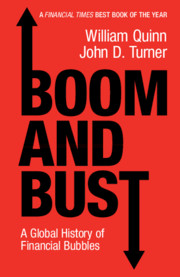Book contents
- Boom and Bust
- Boom and Bust
- Copyright page
- Contents
- Figures
- Tables
- Chapter 1 The Bubble Triangle
- Chapter 2 1720 and the Invention of the Bubble
- Chapter 3 Marketability Revived: The First Emerging Market Bubble
- Chapter 4 Democratising Speculation: The Great Railway Mania
- Chapter 5 Other People’s Money: The Australian Land Boom
- Chapter 6 Wheeler-Dealers: The British Bicycle Mania
- Chapter 7 The Roaring Twenties and the Wall Street Crash
- Chapter 8 Blowing Bubbles for Political Purposes: Japan in the 1980s
- Chapter 9 The Dot-Com Bubble
- Chapter 10 ‘No More Boom and Bust’: The Subprime Bubble
- Chapter 11 Casino Capitalism with Chinese Characteristics
- Chapter 12 Predicting Bubbles
- Acknowledgements
- Notes
- Bibliography
- Index
Chapter 8 - Blowing Bubbles for Political Purposes: Japan in the 1980s
Published online by Cambridge University Press: 06 August 2020
- Boom and Bust
- Boom and Bust
- Copyright page
- Contents
- Figures
- Tables
- Chapter 1 The Bubble Triangle
- Chapter 2 1720 and the Invention of the Bubble
- Chapter 3 Marketability Revived: The First Emerging Market Bubble
- Chapter 4 Democratising Speculation: The Great Railway Mania
- Chapter 5 Other People’s Money: The Australian Land Boom
- Chapter 6 Wheeler-Dealers: The British Bicycle Mania
- Chapter 7 The Roaring Twenties and the Wall Street Crash
- Chapter 8 Blowing Bubbles for Political Purposes: Japan in the 1980s
- Chapter 9 The Dot-Com Bubble
- Chapter 10 ‘No More Boom and Bust’: The Subprime Bubble
- Chapter 11 Casino Capitalism with Chinese Characteristics
- Chapter 12 Predicting Bubbles
- Acknowledgements
- Notes
- Bibliography
- Index
Summary
Chapter 8 examines the land and stock market bubbles that occurred in Japan in the 1980s. In the seven years before its peak, the Japanese stock market appreciated 386 per cent. Similarly, land prices rose by 207 per cent. By August 1992, the Japanese stock market had fallen 62 per cent from its peak, and by 1995, land was 50 per cent below its peak. Both land prices and the stock market continued to fall into the next decade. The chapter then uses the bubble triangle to explain the Japanese land and stock bubbles. These bubbles were purely political creations. Not only did the Japanese government provide the spark, but it systematically cultivated all three sides of the bubble triangle with the explicit goal of generating a boom. This process was clearest in the realm of money and credit, where an expansion was both a central part of Japan’s economic policy and, after the Plaza Accord, an international commitment. The chapter concludes by looking at how the collapse of the Japanese bubbles weakened the country’s banking system, which eventually had to be rescued by the government, and resulted in a stagnant economy for over two decades.
- Type
- Chapter
- Information
- Boom and BustA Global History of Financial Bubbles, pp. 134 - 151Publisher: Cambridge University PressPrint publication year: 2020



